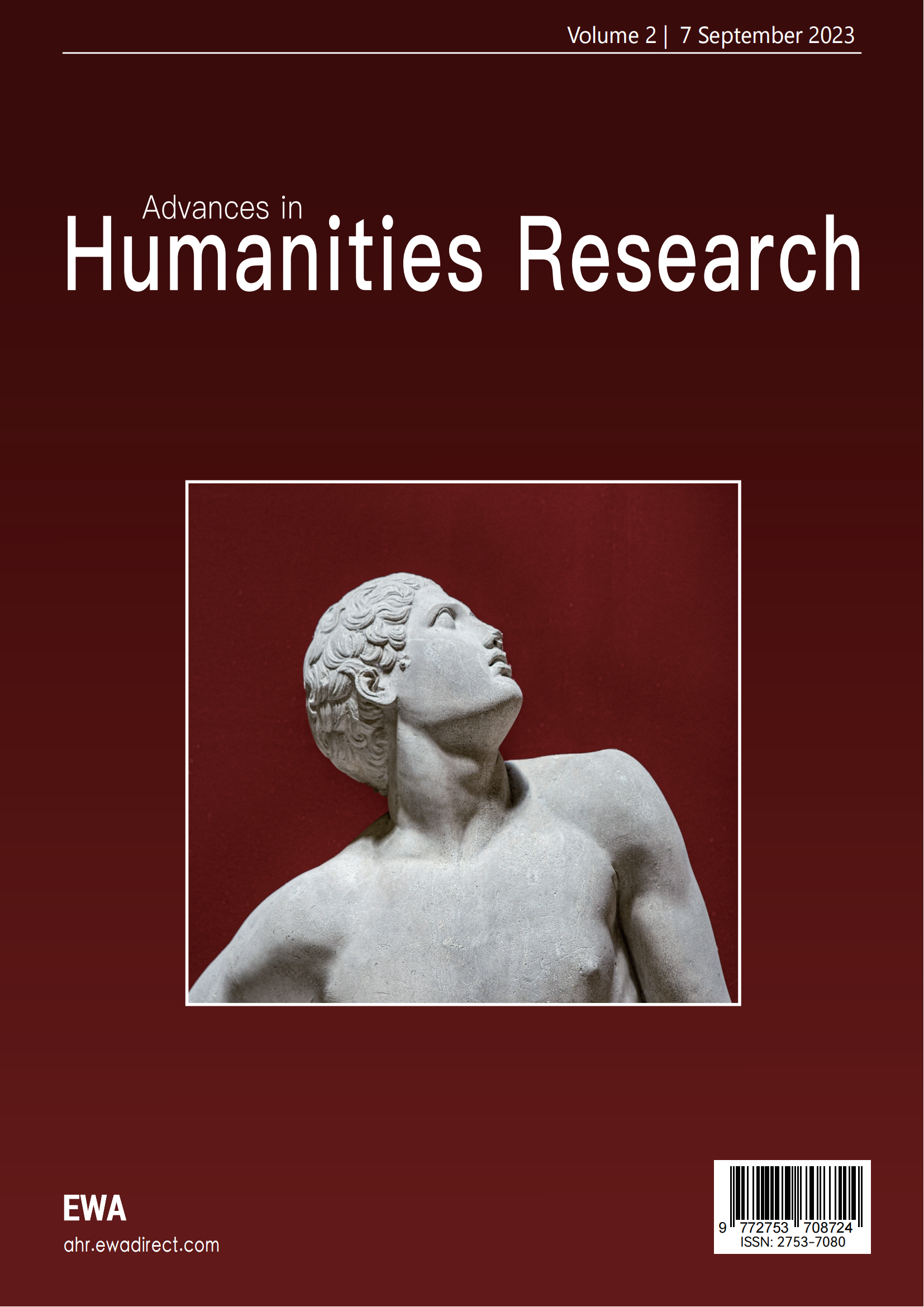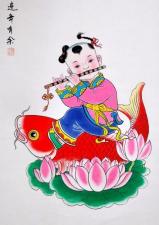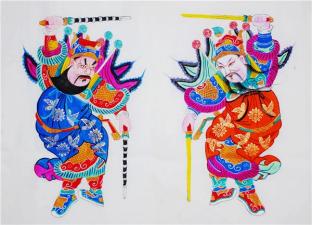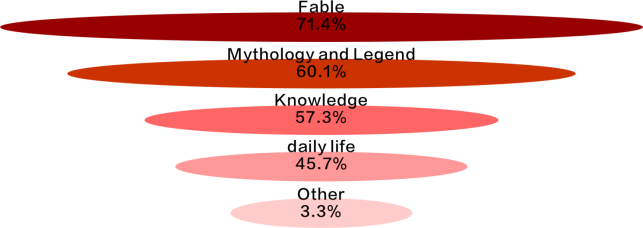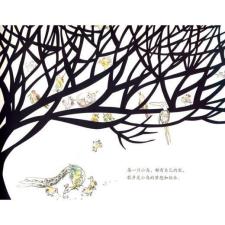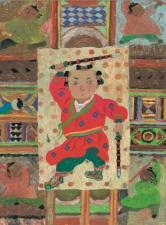1.Introduction
In 1993, Mianzhu City was named the "Township of Chinese New Year Paintings" by the Ministry of Culture of the People's Republic of China. In 1994, Mianzhu New Year's Painting was selected as one of the "Best Chinese Folk Arts" and in 1997, Mianzhu New Year's Painting was awarded the "Gold Medal" at the 5th China Arts Festival. "In 2002, Mianzhu New Year Painting was selected as one of the first intangible cultural heritage items in China. Because of his unique style, he has been exhibited in 30 countries and regions, including the United States, France, England, Japan, Upper Volta, Mali and Chile, which is proof of his unique artistic style.
Studies have shown that children's picture books have a profound impact on the development and cultivation of children's early reading comprehension [1]. Children's picture books are also slowly gaining attention from various countries, and as an important vehicle for cultivating children's initial exposure to the world, learning knowledge, and experiencing the charm of art, each country has its own developmental path in the design development of children's picture books with its own national cultural characteristics, most commonly, for example, Japanese picture books incorporate elements of Japanese costumes, Middle Eastern picture books have elements of camels, British regional picture
books have elements of the royal crown, Chinese picture books in China have elements of cheongsam to express the oriental style. However, China's children's picture books, because of their late start, still need to learn more from the world's best picture book design cases, combined with China's own art and education development characteristics, should be more scientific and effective for Chinese children to propose picture book design solutions, so that they are more practical, improve aesthetic ability and understanding of local culture and art at the same time love to read, and promote the development of children's language skills and literacy skills to improve.
In the context of the development of China's non-heritage culture, it is of substantial significance that art and aesthetic education premised on cultural heritage and cultural identity is carried out in childhood. Mianzhu New Year paintings are an important part of traditional Chinese culture, and their use in children's picture books helps to pass on and promote Chinese folk art. Through children's picture books, the younger generation can better understand and be exposed to this unique art form and deepen their knowledge and understanding of traditional culture. It can help children everywhere build a sense of identity and pride in traditional Chinese culture, and foster a sense of love and preservation of traditional Chinese culture and art. Mianzhu New Year paintings are known for their delicate lines, vibrant colors and rich symbolism. Incorporating this beauty into children's picture books can increase the attractiveness and artistry of the picture books and allow children to enjoy beauty in the process of reading. At the same time, through the characteristic style of Mianzhu New Year paintings, children can develop an appreciation of art and improve their aesthetic skills.
1.1 Overview of Mianzhu New Year Painting Art
1.1.1 The History and Origin of the Art of Mianzhu New Year Painting
Mianzhu New Year paintings are a traditional art form with a long history in China, having been developed over thousands of years as a folk handicraft art with the evolution of social customs and the development of printing technology. In Chinese folklore, the New Year painting is a symbol of the New Year, and it is not a New Year unless the New Year painting is put up. It is not only a decoration for festivals, but also a reflection of local cultural and artistic values.
During this period, with the development of commercial economy and the introduction of
religious culture, the content and form of New Year paintings were greatly enriched. There were paintings reflecting the interest of the court and the citizens, rough and simple paintings full of
countryside, vivid and colorful paintings, delicate and neat paintings, and paintings expressing the painter's personal thoughts and rich emotions.
During the Tang and Song dynasties, the Sichuan region of China was already known as a center of engraving and printing, and the art of engraving and printing was already well developed. Based on this, many scholars believe that Mianzhu New Year paintings came into being in the Song
Dynasty. It is recorded that the imperial historian Zhao Ji of the Northern Song Dynasty mentioned in his book Chengdu Ancient and Modern Records that "the lantern market was held in the first
month, the wine market in the tenth month, the plum market in the eleventh month, and the peach- flag market in the twelfth month" [2]. This means that during the Northern Song Dynasty, the
market in Chengdu, Sichuan, already had peach charms as a trading commodity, and had become a mature market for New Year paintings, with a fixed supply and demand. Thus, it is clear that
Mianzhu New Year paintings had been produced before the Northern Song Dynasty and had developed into a mature market by the Northern Song Dynasty.
Fig. 1. Mianzhu New Year painting 'Door God' Fig. 2. Mianzhu New Year
painting 'Annual surplus'
During the Chongzhen period of the Ming Dynasty, the country was plagued by internal and external problems, political chaos and economic decay, and the Sichuan region was plagued by war and population decline. The Mianzhu New Year painting artists and workshops were not spared either. In the Qing Dynasty, due to political stability and economic development, many places in Sichuan built guild houses, and Mianzhu artists were invited to paint beams, walls and sculptures of gods and goddesses. Due to the development of the local hand-made paper industry in Mianzhu, there was a kind of "powder paper" with crystal and delicate texture, rich color, no falling, no delamination, no dipping, no discoloration, and the paper presented bright colors and effects loved by the people. Therefore, during the Qianlong and Jiaqing years, the production scale of Mianzhu New Year paintings became larger and more people were employed, "according to incomplete statistics, there were more than 300 New Year painting workshops in the county and many towns in the southwest suburbs of the city.
There are more than 1,000 artists and tens of thousands of people engaged in the production of New Year's paintings, including helpers." In addition to meeting domestic demand, the products were also exported to India, Japan, Vietnam, Myanmar and other countries. During the Qing Dynasty, the industry gradually matured and the Fuxi Association, an organization that managed the industry, was established to regulate the industry, set production rules and hold meetings. It was held twice a year to evaluate the paintings to ensure quality and to inject fresh blood into the industry, to promote the development of the industry through competition, and to reflect the scale of production of Mianzhu paintings[3]. In the late Republic of China, the war affected the development of the local economy and greatly weakened the purchasing power of the masses for the New Year paintings, and the market for New Year paintings was not as good as before.
Many folk artisans disappeared. After 1960, Mianzhu New Year Painting gradually gained the attention of the national and local governments, and the Mianzhu area established the "Mianzhu County Woodblock New Year Painting Research Association" and the "Mianzhu New Year Painting Research Association" one after another. Until now, with the continuous innovation of Mianzhu government and Mianzhunianhua-related organizations, they have joined the road of double creation and developed many products with local characteristics.
1.1.2 Techniques and Characteristics of the Art of Mianzhu New Year Painting
Mianzhu New Year paintings are divided into two categories, one is red goods, which refers to the richly colored New Year paintings, mainly with painting strips, doufang and door gods, etc. Most of them are door paintings. The other category is black goods, which are woodblock topiaries made with
vermilion or ink, and the content is mainly portraits of celebrities, flowers and birds, and landscapes. The themes of Mianzhu New Year paintings are mainly to avoid evil and welcome goodluck, customs and traditions, myths and legends, satirical humor, opera stories, historical figures, etc[4]. which basically reflect the idealized and beautiful morals of the local people and also reflect the life and culture of the people at that time.
Mianzhu New Year paintings emphasize the importance of hand-painting, which is different from the overprinting method of other local New Year paintings. After printing the ink line version, Mianzhu New Year paintings advocate the creation of New Year paintings by folk artists through hand-painting. Based on this, in the process of painting the New Year paintings, the artists incorporate their own emotional perceptions and effectively realize their own creativity and imagination, thus effectively enhancing the infectiousness of the works.
Through development,a local jingle has been formed for the basic points of hand-painting, namely "one black, two white and three gold, colorful clothes", in which "one black" refers to the first step of printing on paper with black lines using a woodblock, and "two white" refers to the second step of printing on paper with black lines. "Two white" refers to the second step of painting white on the hands, face and the bottom of the boots of the characters; "three golden yellow" refers to the third step of painting orange on the props and character costumes where appropriate; after the above three steps are completed, it is necessary to play each artist's After the above three steps are completed, each artist's subjective perception needs to be brought into play to fill the character's costume with color, so as to effectively express the infectious power of the character's image [5].
The colors are vivid and exaggerated, and the use of contrast makes people feel a festive and auspicious yet very tense national characteristics, such as the use of red-green and blue-orange, with sharp contrast and contrasts, which not only attract the eye but also extraordinarily bring out the festive atmosphere[6].
1.2 The Importance and Role of Picture Books in Early Education
1.2.1 The Importance of Visual Stimulation in Children's Learning
Andri Savva's study about young children's preference for abstract art and their positive response to images depicting bright colors and familiar/favorite subjects [7].
Furthermore, the human brain derives 75% of all information it processes from visual patterns. At a very young age, children naturally acquire some basic skills through the observation, appreciation, and comprehension of images as they are drawn to the pictures, colors, and forms in picture books. In Evelyn Arispe and Morag Stössl's project "Children Reading Picture Books", there is ample evidence that some young children are able to respond to picture books in a very intelligent and perceptive way, far beyond their developmental expectations[8]. The "Early Childhood Visual Image Response Questionnaire" shows that children are more concerned with the superficial aspects of everyday visual images such as shapes, colors, and lines, and less so with self-reflection. The visual stimuli in early childhood are more likely to be simple shapes, colors, and lines based on aesthetic elements. According to Parsons' theory of aesthetic development, children in the first stage of development are more concerned with instinctive pleasure, they like brightly colored paintings, they do not think too much about the relationship between the subject and object, and the interaction between the viewer and the creator. They do not give much thought to the relationship between the subject and object and the interaction between the viewer and the creator, and are less likely to analyze the work itself. In the second stage, children begin to pay attention to their own experiences, and they begin to accept the opinions and feelings of others, preferring realistic appreciation of works, where the realism of the work and the use of art techniques are the criteria by which they make judgments. In the third stage, children judge works mainly from the perspective of the experience they have
gained in appreciating them, and are able to perceive their own unique experiences, grasp the thoughts and feelings of others and the creativity and originality and depth of content become the criteria for children's judgment. The majority of young children's development is in the first three stages of development as described by Parnass[9].
1.2.2The Positive Effects of Picture Books on Language Learning and Literacy
Sulzby (1985) argued that the preschool years are a very important stage in the development of children's ability to read with words, both in the natural development of children's reading and in the strategic and interactive development of children [10]. Relevant studies have shown that one of the greatest values of picture book reading is its ability to promote the development of children's language skills. During children's picture book reading, children not only gain opportunities for language learning but also acquire skills related to early reading [11].
In a longitudinal study of children's early language development, Wells (1985) found that 50% of a 2-year-old's speech occurred during picture book reading, and further studies found that mothers used instructional behaviors when using picture books to tell stories [12]. Niew and Bruner (1978), in a 10-month study of mothers and children, found that mothers showed more labeling object behavior during picture book reading and provided resultant feedback on the children's naming, which undoubtedly helped children to acquire vocabulary and language more quickly and accurately [13].
Luther's study pointed out that reading is one of the most important skills in the early development of basic skills in young children. This is because children usually prefer pictures to words, and Retnowatietal. stated that telling storybooks can be effective in improving reading skills in children aged 5-6 years. One of the most commonly used principles for implementing early childhood education is learning while playing, or learning through play, and learning must be fun, creative, and appropriate for the child's developmental level. By using these picture book storytelling methods, children will be able to identify letters more easily and enjoyably[14].
These studies are evidence of the positive role that picture books play in early childhood language learning and literacy learning.
2. Methodology
2.1 Children's Favorite Picture Book Research Data
Nie Pan's researchon children's favorite picture books found that 64% of children's favorite picture books were original picture books from abroad, with European and American picture books accounting for 54% and Japanese and Korean picture books accounting for 8% and 2%, respectively. Among the picture books mentioned, 71% ranked first in the theme of story picture books, of which fairy tale fables and myths and legends are the most loved. The second ranking is the knowledge category of picture books, which is related to the natural curiosity of children, science picture books are more popular among knowledge picture books[15]. From a role perspective, more than 75% of children gain knowledge and understanding of the world from picture books, followed by the role of stimulating imagination and promoting aesthetic education in picture books, in addition to learning to get along with people, language expression, emotional regulation is also valued in reading picture books. These indicate that picture books play an important role in children's brain development, personality building, and mental health.
Fig. 3. Children's favorite picture books produce national pie charts
When analyzing the elements of picture books that children like, "fun" is the most frequently mentioned factor, which means that fun is the most important element that attracts readers to picture books, which is very much inline with the nature of children. In addition, "knowledge", "imagination", "special pictures" are also commonly mentioned factors, so it seems that picture books are all-round in the influence of children. Picture books that have fun, story, knowledge, visual impact, and imagination are more popular among children.
Fig. 4. Percentage Chart of Children's Favorite Picture Book Themes
2.2 Design principles of Mianzhu New Year Painting Art Style in Children's Picture Books
The use of Mianzhu New Year painting art style in children's picture books has great potential, as we can see from the previous research and literature in the related field. It is of great significance as the dissemination of Chinese local non-heritage culture, and we can set the design principles from three perspectives: subject matter, color, and composition.
2.2.1 Story Theme
In the choice of subject matter, we should use the picture book research data in recent years, conform to the law of children's brain development, respect children's preferences, and enhance the fun. Firstly, we should create or use children's favorite fables or myths and legends, and secondly, we should set
up age-appropriate knowledge interactions that can play a positive role in children's language learning and literacy.
2.2.2 Stylistic Features
Stylistic features require the creator to organize the expressive objects in a reasonable shape and size according to the subject matter and content, to use some creative expression techniques, and to combine the artistic features of a certain artistic style of composition, which can use specific patterns, signs and symbols to build a coordinated and complete picture. Express the lively and pleasant story picture belonging to the children's stage. In the shape of the need to exaggerate the technique, so that the picture visual produce interesting, to meet the attention development needs of the child stage.
2.2.3 Use of Color
Children's picture books are very important in the creation of color matching, through the law of children's aesthetics, as well as children's favorite picture books research data, children generally prefer bright and vivid colors, and Mianzhu New Year paintings have the characteristics of high saturation, bright colors, strong contrast with obvious color tension, to bring the audience a strong visual impact.
2.3 Case Study
We positioned the 4-6 years old stage and selected two children's picture books that also incorporate traditional Chinese culture and art style, a picture book that incorporates the art of Chinese paper- cutting and a picture book that incorporates the art of Chinese Mianzhu New Year paintings, both of which are excellent examples of award-winning picture books to compare and analyze:
Case 1: "The Cloud-like Pachyderm
The illustrated book artist, Yu Rong, combined her senses of life in Cambridge to create the illustrated book "The Cloud-like Pug", which won the "Golden Apple" award at the 24th Bratislava International Biennial of Illustration (BIB) Children's Book Exhibition. The author of this picture book combines the true story of her adoption of Buster with the unique traditional Chinese art form of paper cutting to create the picture book. This picture book has a positive effect on the international spread of traditional Chinese art forms.
The story of the illustrated book "Cloud-like Pachyderm" is based on love, telling the story of the protagonist Pachyderm intruding into human life, and after experiencing the psychological changes of ups and downs, Pachyderm finally returns to nature to embrace the mountains and clouds. The image design is created in the style of traditional Chinese paper-cutting art, with a strong sense of contour[16], and exaggerated images are presented by deformation techniques. However, the expression of the main shape is relatively rigid, such as the large tree shape has a change of thickness and a sense of space, but lacks vitality, resulting in a lack of vitality in the picture, because the tree shape is too eye-catching, resulting in the image of the bird in the picture being weakened (Fig. 1). Although from the point of view of art design is a good traditional art form integration of picture books, but through the children's favorite picture books research data, the color is relatively single and relatively weak color stimulation, not quite in line with the number of children's favorite picture books research, paper cut art in the creation of children's picture books have certain limitations, the visual appeal of relatively weak, can be done accordingly to improve.
Fig. 5. Picture book "The Cloud-like Pug" 1
Fig. 6. Picture book "The Cloud-like Pug" 2
Case 2: "Bao'er
One of the more successful Chinese picture book artists is Cai Gao, whose picture books are bold in color and interesting in content, mostly adapted from traditional Chinese culture or stories, and are full of knowledge and fun. Cai Gao's picture book works are so famous in Korea and Japan that famous Japanese book designer Kohei Sugiura said, "Reading her books, I have the urge to recite them out loud without realizing it." Cai Gao won the "Golden Apple" award at the 14th Bratislava International Children's Book Fair (BIB), the first person in China to receive this award, which shows the exquisite level of her picture books.
Cai Gao's picture book "Bao'er" is an adaptation of the famous Chinese novel "Liaozhai Zhiyi" from the Qing dynasty, in which the story is based on real life feelings and the main character uses wisdom and courage to hunt a fox demon to save his mother[17]. The picture is created with Chinese characteristics,cleverly using the color scheme of Mianzhu New Year paintings. The black and white colors of the black and white woodblock prints are used as the background of the picture to create a suspenseful atmosphere, and the red and green colors are used as the main body to highlight the story content and connect the main story line with a high saturation of red and green contrasting color relationship (Fig. 2). The main character's brave and upright spirit is used as a folk belief to express the character's characteristics. The exaggerated and deformed shape makes the picture more lively and brings it closer to the children. It is easier to attract children's attention and curiosity, and the content is more inspiring for children to learn to be brave and learn to find solutions to problems, full of positive energy.
Fig. 7. Picture book "Bao'er" 1 Fig. 8. Picture book "Bao'er" 2
3. Results
This paper focuses on a case study of children's picture books of the same nature through a literature review, borrowing the results and data from a questionnaire, which shows that children respond more positively when they are visually stimulated by bright colors. Secondly, starting picture book reading early in children's lives will help them acquire the use of vocabulary and language more quickly and accurately. And the data from the questionnaire on children's favorite picture books showed that 71% of children like fairytale fables and myths and legends stories. In summary, two typical examples of children's picture books with traditional art styles were selected for comparative analysis in terms of stylistic features, color usage, and story themes. In the process, it was found that, in terms of modeling characteristics, Case 1 "Cloud-like Buster" and Case 2 "Bao'er" both use exaggerated modeling, but in terms of traditional art style, Case 1's paper-cutting art style is slightly dull, while Case 2 is more vivid. In the use of color, the same contrasting relationship between black and color is used, with the main body of Case 1 expressed in black and the main body of Case 2 expressed in color, which is more attractive to the audience of children's picture books. In the direction of the story subject both choose fables, case 1 with life and love as the main line to express the story between people and animals, case 2 with heroic color as the main line to express the story before people and monsters, the latter more curious by children's attention. After a comprehensive analysis, the picture book integrating the art style of Mianzhu New Year painting is more visually stimulating to children to produce positive reactions, more inline with the type of picture book children like, and more suitable for children to read.
4. Conclusions
Through combing the history and origin of the art of Mianzhu New Year painting, we understand the characteristics of the thematic content, artistic techniques and artistic styles of Mianzhu New Year painting art. In Andri Savva's study, it was shown that children respond more positively to saturated, bright colors. (1985) conducted a longitudinal study of children's early language development. The analysis of children's picture book reading questionnaire by Nie Nirvana reported that the research data on children's tendency to like picture books shows that children's choice of topic for picture books is more inclined to fairy tale fables and myths and legends, followed by knowledge picture books. The art style of Mianzhu New Year paintings has great potential to be explored in the picture book field, and many aspects of its artistic characteristics can be highly extended and integrated, such as the themes, shapes, colors, and techniques of Mianzhu New Year paintings. When children's
picture books incorporate traditional art styles in the creation of children's picture books, more fairy tale fables and myths and legends from regional cultures can be explored or created, and relevant knowledge content can be set and incorporated into children's picture books with different themes. In the visual design of images, it is necessary to meet the different visual needs of preschool children, enhance their interest and attention, expand their cognition of art styles, and improve their aesthetic ability. Traditional Chinese art and its styles, when created with the integration of children's picture books, can contribute positively to the dissemination of traditional Chinese art and children's language learning and literacy skills.
References
[1]. Schwanenflugel, PJ & Knapp, NF, ‘The Psychology of Reading: Theory and Applications’, Guilford, New York( 2016).
[2]. Ning Zhiqi,Study of Chinese Mianzhu Stencil New Year Paintings:Sichuan Art Publishing House(2011),7
[3]. Huang Xiao,The Research of Mianzhu New Year Pictures in The Background Of Cultural Industry:The Artistic Theory(2019),10-11
[4]. Ma Chunyu,Research on The Application of Wood-Block New Year Picture Elements in Children’s Picture Book,Master's degree thesis(2022)10-13
[5]. Yang Shuang,The Characteristics of Mianzhu New Year Paintings and Their Development in the New Ere:Art Research(2021)2,21-22
[6]. Li Huiru,Li Yue.The Use and Research of Mianzhu New Year Paintings in Cultural and Creative Product Design:Artistic Research,(2021)2,166-167
[7]. Andri Savva,Children’s Responses to Visual Images: Preferences, Functions and Origins:Beyond Textual Literacy: Visual Literacy for Creative and Critical Inquiry(2011)1-14
[8]. (UK) Morag Stiles and (UK) Martin Salisbury,Children’s Picture Book Creation Guide: The Art of Visual narrative: Second Edition; Translated by Wen Aining Beijing: Beijing Fine Arts Photography Publishing House(2021)
[9]. Niu Xiaobing,A Survey and Study on Children's Visual Image Response from the Perspective of Visual Culture - Taking Shanghai as an Example:Master's degree thesis(2017)47
[10]. Sulzby, E. (1985). Children's emergent reading of favorite story-books: A developmental study. Reading Research Quarterly, 20(4), 458-481.
[11]. Snow, C. E. (1983). Literacy and language: Relationships during the preschool years. Harvard Educational Review, 53:165-189.
[12]. Wells, G. Language, learning, and education: Selected Papers from the Bristol study, language at home and at school. Philadelphia, PA: NFER-Nelson, 1985
[13]. Ninio, A., & Bruner, J. (1978). The achievement and antecedents of labeling:Joual of Child Language, 5, 1-15.
[14]. Endri Yanni and Delfi Eliza,The Effect of Storytelling Picture Book on Reading Readiness of Group B Kindergarten Children in Padang:Conference: International Conference of Early Childhood Education,(2020)132-135
[15]. Nie Pan,Analysis Report on the Children's Picture Book Reading Survey Questionnaire:Art Observation,(2020)298,28-32
[16]. Xi Weiyao,Research on the Application of Traditional Paper Cuttings Art in Picture Books:Paper information(2021)12,77-78
[17]. Tan Fengxia,To Give Chinese Children fa Memorable China':the Trend of Chinese Indigenous Picture Books:Jounal of Cambridge Studies(2012),7,143-151
Cite this article
Chencheng,M.;Sharudin,S.A. (2023). Application of Mianzhu New Year Painting Art Style in Children’s Picture Books. Advances in Humanities Research,2,37-46.
Data availability
The datasets used and/or analyzed during the current study will be available from the authors upon reasonable request.
Disclaimer/Publisher's Note
The statements, opinions and data contained in all publications are solely those of the individual author(s) and contributor(s) and not of EWA Publishing and/or the editor(s). EWA Publishing and/or the editor(s) disclaim responsibility for any injury to people or property resulting from any ideas, methods, instructions or products referred to in the content.
About volume
Journal:Advances in Humanities Research
© 2024 by the author(s). Licensee EWA Publishing, Oxford, UK. This article is an open access article distributed under the terms and
conditions of the Creative Commons Attribution (CC BY) license. Authors who
publish this series agree to the following terms:
1. Authors retain copyright and grant the series right of first publication with the work simultaneously licensed under a Creative Commons
Attribution License that allows others to share the work with an acknowledgment of the work's authorship and initial publication in this
series.
2. Authors are able to enter into separate, additional contractual arrangements for the non-exclusive distribution of the series's published
version of the work (e.g., post it to an institutional repository or publish it in a book), with an acknowledgment of its initial
publication in this series.
3. Authors are permitted and encouraged to post their work online (e.g., in institutional repositories or on their website) prior to and
during the submission process, as it can lead to productive exchanges, as well as earlier and greater citation of published work (See
Open access policy for details).
References
[1]. Schwanenflugel, PJ & Knapp, NF, ‘The Psychology of Reading: Theory and Applications’, Guilford, New York( 2016).
[2]. Ning Zhiqi,Study of Chinese Mianzhu Stencil New Year Paintings:Sichuan Art Publishing House(2011),7
[3]. Huang Xiao,The Research of Mianzhu New Year Pictures in The Background Of Cultural Industry:The Artistic Theory(2019),10-11
[4]. Ma Chunyu,Research on The Application of Wood-Block New Year Picture Elements in Children’s Picture Book,Master's degree thesis(2022)10-13
[5]. Yang Shuang,The Characteristics of Mianzhu New Year Paintings and Their Development in the New Ere:Art Research(2021)2,21-22
[6]. Li Huiru,Li Yue.The Use and Research of Mianzhu New Year Paintings in Cultural and Creative Product Design:Artistic Research,(2021)2,166-167
[7]. Andri Savva,Children’s Responses to Visual Images: Preferences, Functions and Origins:Beyond Textual Literacy: Visual Literacy for Creative and Critical Inquiry(2011)1-14
[8]. (UK) Morag Stiles and (UK) Martin Salisbury,Children’s Picture Book Creation Guide: The Art of Visual narrative: Second Edition; Translated by Wen Aining Beijing: Beijing Fine Arts Photography Publishing House(2021)
[9]. Niu Xiaobing,A Survey and Study on Children's Visual Image Response from the Perspective of Visual Culture - Taking Shanghai as an Example:Master's degree thesis(2017)47
[10]. Sulzby, E. (1985). Children's emergent reading of favorite story-books: A developmental study. Reading Research Quarterly, 20(4), 458-481.
[11]. Snow, C. E. (1983). Literacy and language: Relationships during the preschool years. Harvard Educational Review, 53:165-189.
[12]. Wells, G. Language, learning, and education: Selected Papers from the Bristol study, language at home and at school. Philadelphia, PA: NFER-Nelson, 1985
[13]. Ninio, A., & Bruner, J. (1978). The achievement and antecedents of labeling:Joual of Child Language, 5, 1-15.
[14]. Endri Yanni and Delfi Eliza,The Effect of Storytelling Picture Book on Reading Readiness of Group B Kindergarten Children in Padang:Conference: International Conference of Early Childhood Education,(2020)132-135
[15]. Nie Pan,Analysis Report on the Children's Picture Book Reading Survey Questionnaire:Art Observation,(2020)298,28-32
[16]. Xi Weiyao,Research on the Application of Traditional Paper Cuttings Art in Picture Books:Paper information(2021)12,77-78
[17]. Tan Fengxia,To Give Chinese Children fa Memorable China':the Trend of Chinese Indigenous Picture Books:Jounal of Cambridge Studies(2012),7,143-151





